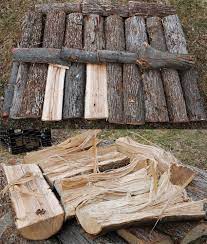
Hickory is a favoured choice among artisans, carpenters, and even barbecue enthusiasts for its strength, durability, and the aromatic smoke it produces. However, one of the most common questions posed by those new to woodwork or the timber trade is, “What does hickory wood look like when split?” Here’s a comprehensive guide.
Introduction to Hickory:
Hickory is a type of hardwood native to North America and parts of Asia. Known for its toughness, hickory has been used for centuries to craft items that require strength, such as tool handles, furniture, and flooring.
Characteristics of Unsplit Hickory:
Before diving into its appearance post-split, it’s essential to identify the characteristics of unsplit hickory:
- Colour: Hickory heartwood is pale to reddish-brown, while its sapwood is lighter, often creamy or white.
- Grain: Hickory has a prominent, straight grain that’s more open than woods like maple or cherry.
- Texture: It has a somewhat coarse texture with a medium to high lustre.
Recognizing Split Hickory:
When hickory is split, certain features become more pronounced:
- Enhanced Color Contrast: The contrast between the heartwood and sapwood becomes more noticeable. The heartwood may appear deeper in colour, while the sapwood remains light.
- Prominent Grain Patterns: The act of splitting often accentuates hickory’s straight grain, revealing intricate patterns that are both beautiful and unique to each piece.
- Rough Edges: Split hickory will often have rugged edges, showcasing its natural and raw beauty.
Why Split Hickory?
Apart from woodworking, split hickory has other uses:
- Firewood: Hickory is an excellent firewood choice due to its high energy output and the pleasant aroma it gives off when burned.
- Smoking and Barbecuing: Split hickory logs or chips are often used in smoking meats for the rich flavour they impart.
Care Tips for Split Hickory:
If you’re using split hickory for projects, consider the following tips:
- Seal Quickly: To maintain its beauty and prevent decay or discolouration, seal split hickory soon after splitting.
- Store Properly: If used for firewood or barbecuing, store in a dry place to ensure optimal burn and flavour.
Conclusion:
Hickory, with its distinguished appearance and multifaceted uses, remains a popular choice in various industries. Understanding its characteristics, especially when split, can assist wood enthusiasts in selecting the best pieces for their projects or needs. Whether you’re crafting, building, or cooking, hickory promises strength and character in equal measure.